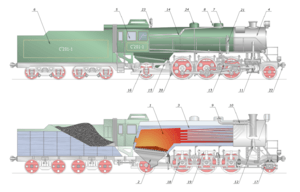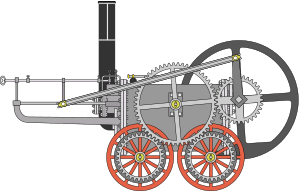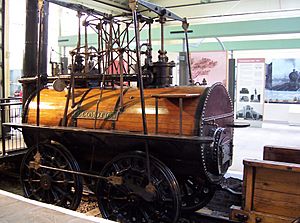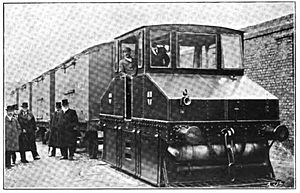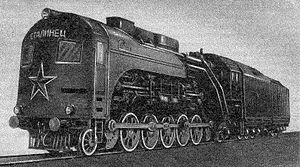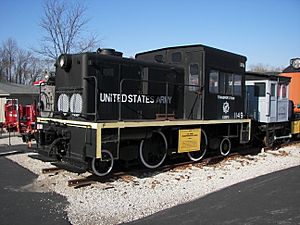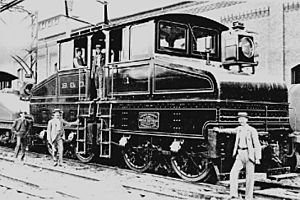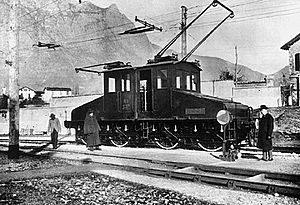Locomotive facts for kids
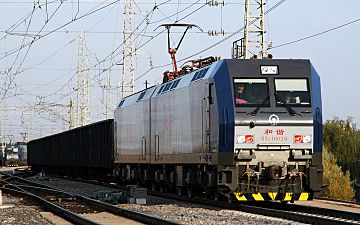
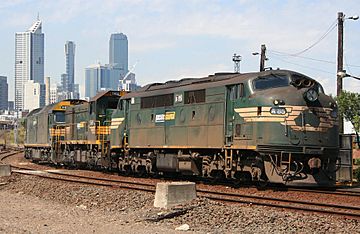
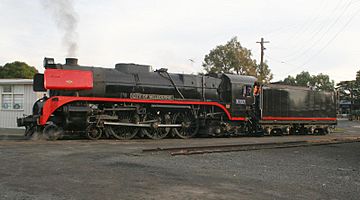
A locomotive or engine is a rail transport vehicle that provides the motive power for a train. If a locomotive is capable of carrying a payload, it is usually rather referred to as multiple units, motor coaches, railcars or power cars; the use of these self-propelled vehicles is increasingly common for passenger trains, but rare for freight.
Traditionally, locomotives pulled trains from the front. However, push-pull operation has become common, where the train may have a locomotive (or locomotives) at the front, at the rear, or at each end.
Contents
Etymology
The word locomotive originates from the Latin loco – "from a place", ablative of locus "place", and the Medieval Latin motivus, "causing motion", and is a shortened form of the term locomotive engine, which was first used in 1814 to distinguish between mobile and stationary steam engines.
Classifications
Prior to locomotives, the motive force for railways had been generated by various lower-technology methods such as human power, horse power, gravity or stationary engines that drove cable systems. Few such systems are still in existence today.
Motive power
Locomotives may generate their power from fuel (wood, coal, petroleum or natural gas), or they may take power from an outside source of electricity. It is common to classify locomotives by their source of energy. The common ones include:
Steam
A steam locomotive is a railway locomotive whose primary power source is a steam engine. The most common form of steam locomotive also contains a boiler to generate the steam used by the engine. The water in the boiler is heated by burning combustible material – usually coal, wood, or oil – to produce steam. The steam moves reciprocating pistons which are connected to the locomotive's main wheels, known as the "drivers". Both fuel and water supplies are carried with the locomotive, either on the locomotive itself or in wagons called "tenders" pulled behind.
The first full-scale working railway steam locomotive was built by Richard Trevithick in 1802. It was constructed for the Coalbrookdale ironworks in Shropshire in the United Kingdom though no record of it working there has survived. On 21 February 1804, the first recorded steam-hauled railway journey took place as another of Trevithick's locomotives hauled a train from the Pen-y-darren ironworks, in Merthyr Tydfil, to Abercynon in South Wales. Accompanied by Andrew Vivian, it ran with mixed success. The design incorporated a number of important innovations that included using high-pressure steam which reduced the weight of the engine and increased its efficiency.
In 1812, Matthew Murray's successful twin-cylinder rack locomotive Salamanca first ran on the edge-railed rack-and-pinion Middleton Railway. Another well-known early locomotive was Puffing Billy, built 1813–14 by engineer William Hedley. It was intended to work on the Wylam Colliery near Newcastle upon Tyne. This locomotive is the oldest preserved, and is on static display in the Science Museum, London. George Stephenson built Locomotion No. 1 for the Stockton and Darlington Railway, north-east England, which was the first public steam railway in the world. In 1829, his son Robert built in Newcastle The Rocket which was entered in and won the Rainhill Trials. This success led to the company emerging as the pre-eminent builder of steam locomotives used on railways in the UK, US and much of Europe. The Liverpool and Manchester Railway, built by Stephenson opened a year later making exclusive use of steam power for passenger and goods trains.
The steam locomotive remained by far the most common type of locomotive until after World War II. The introduction of electric locomotives around the turn of the 20th century and later diesel-electric locomotives spelled the beginning of a decline in the use of steam locomotives, although it was some time before they were phased out of general use. As diesel power (especially with electric transmission) became more reliable in the 1930s, it gained a foothold in North America. The full transition away from steam power in North America took place during the 1950s. In continental Europe, large-scale electrification had replaced steam power by the 1970s. In other parts of the world, transition happened later. Steam was a familiar technology, adapted well to local facilities, and also consumed a wide variety of fuels; this led to its continued use in many countries until the end of the 20th century. By the end of the 20th century, almost the only steam power remaining in regular use around the world was on heritage railways.
Steam locomotives are less efficient than their more modern diesel and electric counterparts and require much greater manpower to operate and service. British Rail figures showed the cost of crewing and fuelling a steam locomotive was some two and a half times that of diesel power, and the daily mileage achievable was far too less.
Kerosene
A kerosene locomotive is an internal combustion engine locomotive using kerosene as the fuel. The kerosene locomotives were the world's first oil locomotives, preceding diesel and other oil locomotives by some years.
A kerosene locomotive was built in 1894 by the Priestman Brothers of Kingston upon Hull for use on Hull docks. This locomotive was built using a 12 hp double-acting marine type engine, running at 300 rpm, mounted on a 4-wheel wagon chassis. It was only able to haul one loaded wagon at a time, due to its low power output, and was not a great success. The first successful kerosene locomotive was "Lachesis" built by Richard Hornsby & Sons Ltd. and delivered to Woolwich Arsenal railway in 1896. The company built a series of kerosene locomotives between 1896 and 1903. These were built for use by the British military.
Petrol
A petrol locomotive is a internal combustion engine locomotive consisting of a petrol engine. ICE engines require a transmission to power the wheels. The engine must be allowed to continue to run when the locomotive is stopped.
Petrol-mechanical locomotives use a mechanical transmission to deliver the power output of petrol engines to the wheels. Most petrol locomotives built were petrol-mechanical locomotives. The first commercially successful petrol locomotive was a petrol-mechanical built by the Maudslay Motor Company in 1902, for the Deptford Cattle Market in London. It was a 80 hp locomotive using a 3-cylinder vertical petrol engine, with a two speed mechanical gearbox. The second locomotive was built by F.C. Blake of Kew in January 1903 for the Richmond Main Sewerage Board. In 1916 Simplex petrol locomotives with 20-40 hp motors and 4-wheel mechanical transmission began to be used on 600 mm (1 ft 11 5⁄8 in) gauge trench railways on the Western Front. The War Department also ordered larger petrol-electric locomotives from Dick, Kerr & Co. and British Westinghouse at the same time: These used a 45 hp petrol engine driving a 500V generator. Many were sold off as surplus at the end of hostilities, finding work on small industrial railways. Motor Rail continued to manufacture and develop the design, for the next few decades.
Diesel
A diesel locomotive is a internal combustion engine locomotive consisting of a diesel engine. Internal combustion engines require a transmission to power the wheels. The engine must be allowed to continue to run when the locomotive is stopped. In the early days of diesel propulsion development, various systems were all employed with varying degrees of success. Of the three, electric transmission proved to be most popular, and although other locomotives have certain advantages and continue to be used, most diesel-powered locomotives today are diesel-electric.
Diesel-mechanical
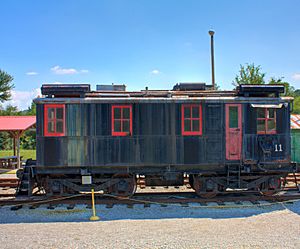
A diesel–mechanical locomotive uses a mechanical transmission to transfer power to the wheels. This type of transmission is generally limited to low-powered, low speed shunting (switching) locomotives, lightweight multiple units and self-propelled railcars. The earliest diesel locomotives were diesel-mechanical.
The mechanical transmissions used for railroad propulsion are generally more complex and much more robust than standard-road versions. There is usually a fluid coupling interposed between the engine and gearbox, and the gearbox is often of the epicyclic (planetary) type to permit shifting while under load. Various systems have been devised to minimise the break in transmission during gear changing; e.g., the S.S.S. (synchro-self-shifting) gearbox used by Hudswell Clarke. Diesel–mechanical propulsion is limited by the difficulty of building a reasonably sized transmission capable of coping with the power and torque required to move a heavy train.
In 1906, Rudolf Diesel, Adolf Klose and the steam and diesel engine manufacturer Gebrüder Sulzer founded Diesel-Sulzer-Klose GmbH to manufacture diesel-powered locomotives. The Prussian State Railways ordered a diesel locomotive from the company in 1909. The world's first diesel-powered locomotive (a diesel-mechanical locomotive) was operated in the summer of 1912 on the Winterthur–Romanshorn railway in Switzerland, but was not a commercial success. The locomotive weight was 95 tonnes and the power was 883 kW with a maximum speed of 100 km/h. Small numbers of prototype diesel locomotives were produced in a number of countries through the mid-1920s.
Diesel-electric
In a diesel–electric locomotive, the diesel engine drives either an electrical DC generator (generally, less than 3,000 horsepower (2,200 kW) net for traction), or an electrical AC alternator-rectifier (generally 3,000 horsepower (2,200 kW) net or more for traction), the output of which provides power to the traction motors that drive the locomotive. There is no mechanical connection between the diesel engine and the wheels. The vast majority of diesel locomotives today are diesel-electric.
The important components of diesel–electric propulsion are the diesel engine (also known as the prime mover), the main generator/alternator-rectifier, traction motors (usually with four or six axles), and a control system consisting of the engine governor and electrical or electronic components, including switchgear, rectifiers and other components, which control or modify the electrical supply to the traction motors. In the most elementary case, the generator may be directly connected to the motors with only very simple switchgear.
Originally, the traction motors and generator were DC machines. Following the development of high-capacity silicon rectifiers in the 1960s, the DC generator was replaced by an alternator using a diode bridge to convert its output to DC. This advance greatly improved locomotive reliability and decreased generator maintenance costs by elimination of the commutator and brushes in the generator. Elimination of the brushes and commutator, in turn, disposed of the possibility of a particularly destructive type of event referred to as a flashover, which could result in immediate generator failure and, in some cases, start an engine room fire.

In the late 1980s, the development of high-power variable-frequency/variable-voltage (VVVF) drives, or "traction inverters," has allowed the use of polyphase AC traction motors, thus also eliminating the motor commutator and brushes. The result is a more efficient and reliable drive that requires relatively little maintenance and is better able to cope with overload conditions that often destroyed the older types of motors.
In 1914, Hermann Lemp, a General Electric electrical engineer, developed and patented a reliable direct current electrical control system (subsequent improvements were also patented by Lemp). Lemp's design used a single lever to control both engine and generator in a coordinated fashion, and was the prototype for all diesel–electric locomotive control. In 1917–18, GE produced three experimental diesel–electric locomotives using Lemp's control design. In 1924, a diesel-electric locomotive (Eel2 original number Юэ 001/Yu-e 001) started operations. It had been designed by a team led by Yuri Lomonosov and built 1923–1924 by Maschinenfabrik Esslingen in Germany. It had 5 driving axles (1'E1'). After several test rides, it hauled trains for almost three decades from 1925 to 1954. It was the world's first functional diesel locomotive.
Diesel-hydraulic
Diesel–hydraulic locomotives use one or more torque converters, in combination with gears, with a mechanical final drive to convey the power from the diesel engine to the wheels.
Hydrokinetic transmission (also called hydrodynamic transmission) uses a torque converter. A torque converter consists of three main parts, two of which rotate, and one (the stator) that has a lock preventing backwards rotation and adding output torque by redirecting the oil flow at low output RPM. All three main parts are sealed in an oil-filled housing. To match engine speed to load speed over the entire speed range of a locomotive some additional method is required to give sufficient range. One method is to follow the torque converter with a mechanical gearbox which switches ratios automatically, similar to an automatic transmission on a car. Another method is to provide several torque converters each with a range of variability covering part of the total required; all the torque converters are mechanically connected all the time, and the appropriate one for the speed range required is selected by filling it with oil and draining the others. The filling and draining is carried out with the transmission under load, and results in very smooth range changes with no break in the transmitted power.
The main worldwide user of main-line hydraulic transmissions was the Federal Republic of Germany, with designs including the 1950s DB class V 200, and the 1960 and 1970s DB Class V 160 family. British Rail introduced a number of diesel hydraulic designs during it 1955 Modernisation Plan, initially license built versions of German designs (see Category:Diesel–hydraulic locomotives of Great Britain). In Spain RENFE used high power to weight ratio twin engined German designs to haul high speed trains from the 1960s to 1990s. (see RENFE Classes 340, 350, 352, 353, 354).
Hydraulic drive systems using a hydrostatic hydraulic drive system have been applied to rail use. Examples included 350 to 750 hp (260 to 560 kW) shunting locomotives by CMI Group (Belgium), 4 to 12 tonne 35 to 58 kW (47 to 78 hp) industrial locomotives by Atlas Copco subsidiary GIA. Hydrostatic drives are also utilised in railway maintenance machines (tampers, rail grinders).
These systems are used in some rail applications, primarily low speed shunting and rail-maintenance vehicles.
Diesel-steam
Steam-diesel hybrid locomotives can use steam generated from a boiler or diesel to power a piston engine. The Cristiani Compressed Steam System used a diesel engine to power a compressor to drive and recirculate steam produced by a boiler; effectively using steam as the power transmission medium, with the diesel engine being the prime mover
In the 1940s, diesel locomotives began to displace steam power on American railroads. Following the end of World War II, diesel power began to appear on railroads in many countries. The significantly better economics of diesel operation triggered a dash to diesel power, a process known as Dieselization. By the late 1990s, only heritage railways continued to operate steam locomotives.
Diesel locomotives require considerably less maintenance than steam, with a corresponding reduction in the number of personnel needed to keep the fleet in service. The best steam locomotives spent an average of three to five days per month in the shop for routine maintenance and running repairs. Heavy overhauls were frequent, often involving removal of the boiler from the frame for major repairs. In contrast, a typical diesel locomotive requires no more than eight to ten hours of maintenance per month (maintenance intervals are 92 days or 184 days, depending upon a locomotive's age), and may run for decades between major overhauls. Diesel units do not pollute as much as steam trains; modern units produce low levels of exhaust emissions.
Gas turbine
A gas turbine locomotive is an internal combustion engine locomotive consisting of a gas turbine. ICE engines require a transmission to power the wheels. The engine must be allowed to continue to run when the locomotive is stopped.
Gas turbine-mechanical locomotives, use a mechanical transmission to deliver the power output of gas turbines to the wheels. A gas turbine locomotive was patented in 1861 by Marc Antoine Francois Mennons (British patent no. 1633). There is no evidence that the locomotive was actually built but the design includes the essential features of gas turbine locomotives built in the 20th century, including compressor, combustion chamber, turbine and air pre-heater. In 1952, Renault delivered a prototype four-axle 1150 hp gas-turbine-mechanical locomotive fitted with the Pescara "free turbine" gas- and compressed-air producing system, rather than a co-axial multi-stage compressor integral to the turbine. This model was succeeded by a pair of six-axle 2400 hp locomotives with two turbines and Pescara feeds in 1959. Several similar locomotives were built in USSR by Kharkov Locomotive Works.
Gas turbine-electric locomotives, use a gas turbine to drive an electrical generator or alternator which produced electric current powers the traction motor which drive the wheels. In 1939 the Swiss Federal Railways ordered Am 4/6, a GTEL with a 1,620 kW (2,170 hp) of maximum engine power from Brown Boveri. It was completed in 1941, and then underwent testing before entering regular service. The Am 4/6 was the first gas turbine – electric locomotive. British Rail 18000 was built by Brown Boveri and delivered in 1949. British Rail 18100 was built by Metropolitan-Vickers and delivered in 1951. A third locomotive, the British Rail GT3, was constructed in 1961. Union Pacific ran a large fleet of turbine-powered freight locomotives starting in the 1950s. These were widely used on long-haul routes, and were cost-effective despite their poor fuel economy due to their use of "leftover" fuels from the petroleum industry. At their height the railroad estimated that they powered about 10% of Union Pacific's freight trains, a much wider use than any other example of this class.
A gas turbine offers some advantages over a piston engine. There are few moving parts, decreasing the need for lubrication and potentially reducing maintenance costs, and the power-to-weight ratio is much higher. A turbine of a given power output is also physically smaller than an equally powerful piston engine, allowing a locomotive to be very powerful without being inordinately large. However, a turbine's power output and efficiency both drop dramatically with rotational speed, unlike a piston engine, which has a comparatively flat power curve. This makes GTEL systems useful primarily for long-distance high-speed runs. Additional problems with gas turbine-electric locomotives included that they were very noisy, and they produced such extremely hot exhaust that if the locomotive were parked under an overpass paved with asphalt, it could melt the asphalt.
Electric
An electric locomotive is a locomotive powered only by electricity. Electricity is supplied to moving trains with a (nearly) continuous conductor running along the track that usually takes one of three forms: an overhead line, suspended from poles or towers along the track or from structure or tunnel ceilings; a third rail mounted at track level; or an onboard battery. Both overhead wire and third-rail systems usually use the running rails as the return conductor but some systems use a separate fourth rail for this purpose. The type of electrical power used is either direct current (DC) or alternating current (AC).
Various collection methods exist: a trolley pole, which is a long flexible pole that engages the line with a wheel or shoe; a bow collector, which is a frame that holds a long collecting rod against the wire; a pantograph, which is a hinged frame that holds the collecting shoes against the wire in a fixed geometry; or a contact shoe, which is a shoe in contact with the third rail. Of the three, the pantograph method is best suited for high-speed operation.
Electric locomotives almost universally use axle-hung traction motors, with one motor for each powered axle. In this arrangement, one side of the motor housing is supported by plain bearings riding on a ground and polished journal that is integral to the axle. The other side of the housing has a tongue-shaped protuberance that engages a matching slot in the truck (bogie) bolster, its purpose being to act as a torque reaction device, as well as a support. Power transfer from motor to axle is effected by spur gearing, in which a pinion on the motor shaft engages a bull gear on the axle. Both gears are enclosed in a liquid-tight housing containing lubricating oil. The type of service in which the locomotive is used dictates the gear ratio employed. Numerically high ratios are commonly found on freight units, whereas numerically low ratios are typical of passenger engines.
Electricity is typically generated in large and relatively efficient generating stations, transmitted to the railway network and distributed to the trains. Some electric railways have their own dedicated generating stations and transmission lines but most purchase power from an electric utility. The railway usually provides its own distribution lines, switches and transformers.
Direct current
Earliest systems were DC systems. The first electric passenger train was presented by Werner von Siemens at Berlin in 1879. The locomotive was driven by a 2.2 kW, series-wound motor, and the train, consisting of the locomotive and three cars, reached a speed of 13 km/h. During four months, the train carried 90,000 passengers on a 300-metre-long (984 feet) circular track. The electricity (150 V DC) was supplied through a third insulated rail between the tracks. A contact roller was used to collect the electricity. The world's first electric tram line opened in Lichterfelde near Berlin, Germany, in 1881. It was built by Werner von Siemens (see Gross-Lichterfelde Tramway and Berlin Straßenbahn). The Volk's Electric Railway opened in 1883 in Brighton, and is the oldest surviving electric railway. Also in 1883, Mödling and Hinterbrühl Tram opened near Vienna in Austria. It was the first in the world in regular service powered from an overhead line. Five years later, in the U.S. electric trolleys were pioneered in 1888 on the Richmond Union Passenger Railway, using equipment designed by Frank J. Sprague.
The first electrically-worked underground line was the City and South London Railway, prompted by a clause in its enabling act prohibiting use of steam power. It opened in 1890, using electric locomotives built by Mather and Platt. Electricity quickly became the power supply of choice for subways, abetted by the Sprague's invention of multiple-unit train control in 1897.
The first use of electrification on a main line was on a four-mile stretch of the Baltimore Belt Line of the Baltimore and Ohio Railroad (B&O) in 1895 connecting the main portion of the B&O to the new line to New York through a series of tunnels around the edges of Baltimore's downtown. Three Bo+Bo units were initially used, at the south end of the electrified section; they coupled onto the locomotive and train and pulled it through the tunnels.
DC was used on earlier systems. These systems were gradually replaced by AC. Today, almost all main-line railways use AC systems. DC systems are confined mostly to urban transit such as metro systems, light rail and trams, where power requirement is less.
Alternating current
The first practical AC electric locomotive was designed by Charles Brown, then working for Oerlikon, Zürich. In 1891, Brown had demonstrated long-distance power transmission, using three-phase AC, between a hydro-electric plant at Lauffen am Neckar and Frankfurt am Main West, a distance of 280 km. Using experience he had gained while working for Jean Heilmann on steam-electric locomotive designs, Brown observed that three-phase motors had a higher power-to-weight ratio than DC motors and, because of the absence of a commutator, were simpler to manufacture and maintain. However, they were much larger than the DC motors of the time and could not be mounted in underfloor bogies: they could only be carried within locomotive bodies.
In 1894, Hungarian engineer Kálmán Kandó developed a new type 3-phase asynchronous electric drive motors and generators for electric locomotives. Kandó's early 1894 designs were first applied in a short three-phase AC tramway in Evian-les-Bains (France), which was constructed between 1896 and 1898. In 1918, Kandó invented and developed the rotary phase converter, enabling electric locomotives to use three-phase motors whilst supplied via a single overhead wire, carrying the simple industrial frequency (50 Hz) single phase AC of the high voltage national networks.
In 1896, Oerlikon installed the first commercial example of the system on the Lugano Tramway. Each 30-tonne locomotive had two 110 kW (150 hp) motors run by three-phase 750 V 40 Hz fed from double overhead lines. Three-phase motors run at constant speed and provide regenerative braking, and are well suited to steeply graded routes, and the first main-line three-phase locomotives were supplied by Brown (by then in partnership with Walter Boveri) in 1899 on the 40 km Burgdorf—Thun line, Switzerland. The first implementation of industrial frequency single-phase AC supply for locomotives came from Oerlikon in 1901, using the designs of Hans Behn-Eschenburg and Emil Huber-Stockar; installation on the Seebach-Wettingen line of the Swiss Federal Railways was completed in 1904. The 15 kV, 50 Hz 345 kW (460 hp), 48 tonne locomotives used transformers and rotary converters to power DC traction motors.
Italian railways were the first in the world to introduce electric traction for the entire length of a main line rather than just a short stretch. The 106 km Valtellina line was opened on 4 September 1902, designed by Kandó and a team from the Ganz works. The electrical system was three-phase at 3 kV 15 Hz. The voltage was significantly higher than used earlier and it required new designs for electric motors and switching devices. The three-phase two-wire system was used on several railways in Northern Italy and became known as "the Italian system". Kandó was invited in 1905 to undertake the management of Società Italiana Westinghouse and led the development of several Italian electric locomotives.
Battery-electric
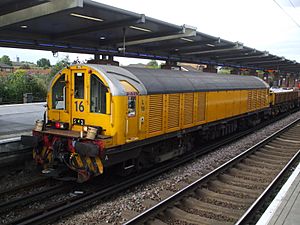
A battery-electric locomotive (or battery locomotive) is an electric locomotive powered by on-board batteries; a kind of battery electric vehicle.
Such locomotives are used where a conventional diesel or electric locomotive would be unsuitable. An example is maintenance trains on electrified lines when the electricity supply is turned off. Another use is in industrial facilities where a combustion-powered locomotive (i.e., steam- or diesel-powered) could cause a safety issue due to the risks of fire, explosion or fumes in a confined space. Battery locomotives are preferred for mines where gas could be ignited by trolley-powered units arcing at the collection shoes, or where electrical resistance could develop in the supply or return circuits, especially at rail joints, and allow dangerous current leakage into the ground.
The first known electric locomotive was built in 1837 by chemist Robert Davidson of Aberdeen, and it was powered by galvanic cells (batteries). Davidson later built a larger locomotive named Galvani, exhibited at the Royal Scottish Society of Arts Exhibition in 1841. The seven-ton vehicle had two direct-drive reluctance motors, with fixed electromagnets acting on iron bars attached to a wooden cylinder on each axle, and simple commutators. It hauled a load of six tons at four miles per hour (6 kilometers per hour) for a distance of one and a half miles (2 kilometers). It was tested on the Edinburgh and Glasgow Railway in September of the following year, but the limited power from batteries prevented its general use.
Another example was at the Kennecott Copper Mine, Latouche, Alaska, where in 1917 the underground haulage ways were widened to enable working by two battery locomotives of 4+1⁄2 tons. In 1928, Kennecott Copper ordered four 700-series electric locomotives with on-board batteries. These locomotives weighed 85 tons and operated on 750-volt overhead trolley wire with considerable further range whilst running on batteries. The locomotives provided several decades of service using Nickel-iron battery (Edison) technology. The batteries were replaced with lead-acid batteries, and the locomotives were retired shortly afterward. All four locomotives were donated to museums, but one was scrapped. The others can be seen at the Boone and Scenic Valley Railroad, Iowa, and at the Western Railway Museum in Rio Vista, California. The Toronto Transit Commission previously operated a battery electric locomotive built by Nippon-Sharyo in 1968 and retired in 2009.
London Underground regularly operates battery-electric locomotives for general maintenance work.
Use
The three main categories of locomotives are often subdivided in their usage in rail transport operations. There are passenger locomotives, freight locomotives and switcher (or shunting) locomotives.
Images for kids
-
A China Railways HXD1D electric locomotive in China
-
Wainwright SECR Class P on the Bluebell Railway, England
-
VR Class Tk3 steam locomotive in the town of Kokkola in Central Ostrobothnia, Finland
-
Bombardier ALP-45DP at the Innotrans convention in Berlin
See also
 In Spanish: Locomotora para niños
In Spanish: Locomotora para niños


